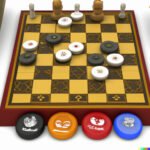Introduction
Battleship, the classic strategy game of naval combat, captivates players of all ages. It’s a timeless game beloved by generations of people. This deceptively simple but exciting game has been around since World War I and has become a staple of party events and afternoon playtime.
Battleship involves two opponents trying to guess the location of their opponent’s ships on a board-like grid. Each player sets out with two fleets consisting of six ships, including an aircraft carrier, battleship, submarine, destroyer, patrol boat, and personnel transport boat. Each player must secretly place their fleets on the grids before beginning to fire at one another’s ships. A miss is indicated by a blank hit marker that has been placed in a square attacked by the opponent’s ship; however, if correct coordinates are announced by a player then their opponent’s ship will be hit ” sinking it upon three hits. The first player who successfully sinks all their opponents’ ships wins the game!
Battleship caters to players who enjoy puzzle-solving strategies while competing against each other in one-on-one competitive play. Players must think strategically in order to best thwart their opponents’ strategies while disguising their own positions – adding an element of thrill and anticipation as you wait for your opponent’s shots! The only way to achieve victory is by successfully guessing their position – no luck here! As such, both luck and strategy unite in this thrilling and fun game for anyone looking for a challenging gaming experience!
History of Battleship, with Examples of Ship Types
Battleship is a two-player strategy game where players must tactically sink their opponent’s fleet of ships before their own fleet is sunk. It has been around since at least World War I, when it was marketed as a pencil and paper guessing game. The modern version of Battleship was first released in 1967, and the game became widely known through Milton Bradley’s best selling board games which were produced from 1967 to 1977.
The traditional game consists of two fleets per player: five sea vessels each (battleships, destroyers, submarines, and patrol boats), arranged on grids. Each ship occupies one or more consecutive squares on the grid and are either placed horizontally or vertically; ships cannot overlap or touch each other. The exact number, size and type of each ship depends on the edition being played, but battleships are typically 5-squares long while patrol boats have only one square. Players use deduction to figure out where their opponent’s ships are located by “firing” missiles in sequence to try and destroy their targets. When all of a papercraft’s vessels are destroyed, they lose the game.
One example of a battleship commonly found in games today is the Aircraft Carrier ” this vessel provides large amounts of firepower over long distances due to its ability to launch fighter aircrafts up into the air with its flight deck attached along the top side of its body. Other examples of naval vessels found in most versions include Destroyers ” which specialize in close range combat and Submarines ” which run almost completely silent below surface depths undetectable by normal radar systems until they launch torpedoes into their targets above water levels. Additionally available vessels include frigates, minesweepers – used for clearing mines from passages – as well as landing crafts such as Troop Transporters for special missions involving amphibious operations like an invasion force breaching enemy shores with human infantry units by sea.
Rules and How To Play the Game, with a Step-by-Step Guide
Step 1: Arrange the boards. Each player should have their own board, and the number of ships must match the numbers given for that particular game. For a classic Battleship game, there will be two separate fleets, each consisting of five different vessels (Carrier, Battleship, Cruiser, Submarine, and Destroyer). Players then take turns placing the ships on their grid by calling out a letter along the top and a number along the side as reference points.
Step 2: Take turns calling out shots with coordinates. Players alternate between calling out coordinates in order to try and guess where they opponent’s ships are located. If they guess correctly they get a “hit” and if they guess incorrectly it is noted as a “miss”. Hits are marked on both players’ boards with an X.
Step 3: Determine when a ship has been sunk. A player’s ship is considered “sunk” when all of its parts have been marked with an X signifying it is no longer intact on the board.
Step 4: Keep track of each other’s moves until one fleet is fully sunk. As play progresses both players should keep careful track of what shots were taken by their opponents and how many hits have landed on which vessel(s). The first player to sink all five vessels in their opponent’s fleet wins!
Pros and Cons of Playing Battleship, Compared to Other Strategy Games
Pros:
-A game of Battleship encourages strategic thinking, problem solving and logical reasoning.
-It can be a fun bonding activity for people of all ages.
-The game only requires one board, making it easily transportable and playable anywhere.
-Unlike many other strategy games, the rules are simple to understand and not too complicated.
Cons:
-It is quite challenging to win in Battleship as players need to use deductive reasoning to guess their opponents’ moves and their locations.
-Playing the game can be quite slow if the two opponents take too long thinking about each shot.
-Due to its relatively basic gameplay, the game can become tedious or monotonous after a few games.
Strategies for Winning Battleship, from Beginner to Advanced Players
Beginner: The best strategy for beginners is to focus on one area of the default grid and observe where the shots are landing. If a ship occupies all or part of that area, use logic to determine the orientation (vertical or horizontal) and length of the ship. Once this has been established, aim shots at bracketing points around it until you hit it in its full length.
Intermediate: In order to reach an intermediate level of game playing, you should focus on the areas where ships could fit the most easily. For example, along five squares in a row where there aren’t any previously hit squares; or two rows with three consecutive spaces between them, etc. Try out various strategies such as beginning from different corners/sides and aiming for maximum damage as this makes it more difficult for your opponent to guess where your ships are located. Additionally, optimize your previous hit pattern and use patterns like ‘skipping’ diagonals which help eliminate large sections at once.
Advanced: At an advanced level of play, you must be able to strategize how your opponent is aiming their shot and paying attention to randomness versus a predictable pattern. Advanced players combine guessing strategies with progressive analysis in order to deduce their opponent’s moves while planning they own shot simultaneously. Acing Defense System positioning also ensures that advanced players don’t fall victim to their opponents’ moves as quickly and effectively preventing opponent ships from being sunk too quickly as well as stopping themselves from navigating through ineffective channels when attacking enemy vessels. They might also consider laying a pretend ship across multiple panels (a fake battleship) while detouring around it before finally sinking it in order to confuse their opponents further on future attacks.
Variations of Battleship, Their Unique Rules and Where to Find Them
Battleship, an iconic game that has been around for many decades, is an exciting game of strategy and patience. Although the classic version of this game remains a favorite among players, there are many delightful variations out there as well. Variations include a range of modifications to the underlying game rules, from adding special dice rolls to changing the shape of the board entirely.
One interesting variation is called Helicopter Battleship. This version requires two additional types of ships on top of those found in standard Battleship: submarines and helicopters. Submarines must stay submerged until attacked, while helicopters are able to “fly” over other ships instead of having to stay within their designated spaces on the board. Additionally, this version also adds several special dice rolls that allow both players to take extra shots at their opponent’s fleets as they attempt to sink them all first.
Another example is 3D-Battleship, which”you guessed it”plays out on a three-dimensional board! As opposed to the standard 2D play style, this War & Strategy Board Game challenges players to mentally manipulate 3D space with the use of colored cubes and cubes featuring different structures (such as skyscrapers) that must be navigated and conquered throughout playtime.
Yet another variant is Cosmic Combat: Asteroid Battleboats”. This game throws literally new methods into battle as each player launches missiles from their battleboat pieces against one another in a bid for domination! Special tokens also add another layer of excitement by providing various power-ups for two or more armies in each round.
These are just a few examples of some popular alternative takes on Battleship…or should we say “Battle Boats?” If you’re looking for something new but still want that classic battleship feel then you can check out any one”or all!”of these enjoyable alternate games wherever board games may be sold or found online
Conclusion
Battleship has left a lasting legacy and continues to captivate players with its strategic game play. While it has been around for nearly a century, the game has evolved over the decades as different adaptations and expansions were released. Today, Battleship is played in many different forms: from classic board games to apps, computer programs, and even video games. This versatility in the way it can be adapted and enjoyed helps explain why it remains an enduringly popular pastime today. The traditional game remains enjoyable thanks to its simple yet strategic gameplay that players of all skill levels appreciate. Even after all these years, Battleship is still deeply engrossing and continues to lure casual gamers as well as tactical veterans alike into hours of intense competition.

I love playing all kinds of games – from classics like Monopoly to modern favourites like Ticket to Ride.
I created this blog as a way to share my love of board games with others, and provide information on the latest releases and news in the industry.





